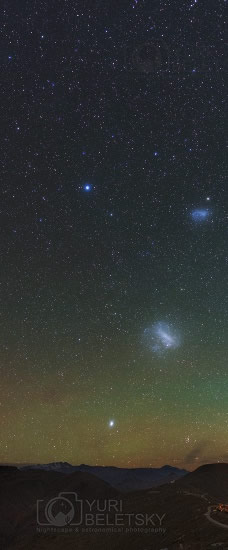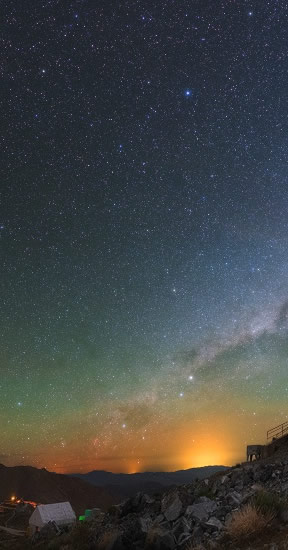Atmospheric
Optics
Earth's Atmosphere Near & Far
Yuri Beletsky captured last Monday's (28 September '15) total lunar eclipse from Carnegie Las Campanas Observatory in the Atacama Desert, Chile.
Scroll right for the larger image.
Image ©Yuri Beletsky, shown with permission
Another layer of Earth's atmosphere also colours the eclipsed moon. Here the edge of the coppery shadow is hued with blues and purples. They are from absorption by the layer of ozone in the stratosphere.
Eva Seidenfaden (paraselene)pictured this scene during an earlier eclipse.
Earth’s fragile gaseous envelope shows its presence on this panorama of the Universe.
Eclipse or not, our large planet cannot blot out its moon for the lower atmosphere refracts sun rays towards the satellite’s centre to light it coppery red. Reds because the double passage in and then out of the troposphere scatters out far more blues than reds from the sunlight. Some eclipses are dark, others are brighter depending on how many clouds happen to block the sunlight.
Earth’s tenuous upper atmosphere, a reasonably good vacuum by laboratory standards, shows up too. Near the horizon the sky is suffused with airglow, at left green and at right red bands.
The green is the forbidden radiation of oxygen atoms 90-100 km high. The red is likely also oxygen atoms even higher. OH (hydroxyl) radicals also emit red airglow at lower altitudes.
Extreme ultra-violet radiation from the sun causes airglow. It electronically excites oxygen atoms and nitrogen atoms in the thermosphere. The excitation is transferred by rare collisions to other components and some eventually lose their energy by chemiluminescence.
Beyond our atmospheric turmoil the Milky Way and companion galaxies shine forth.









